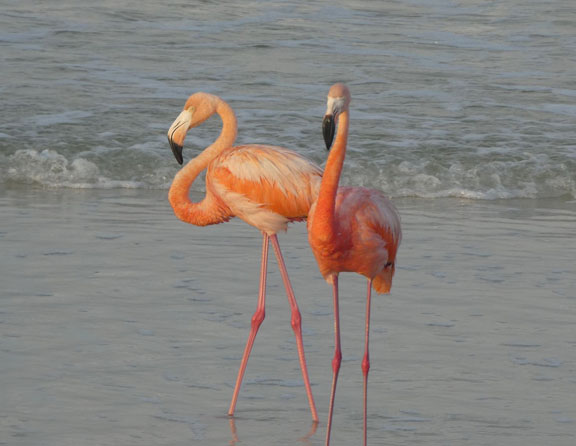
A lot of flurry going on in South Walton County the last few days as a pair of American Flamingos have been spotted along the Gulf not far from Deer Lake State Park.
Initially spotted shorty after tropical storm Cindy passed though the Gulf coast, the flamingos were first seen on Perdido Key near Pensacola, then at a pond on Eglin Air Force Base, and most recently in South Walton. Not native to our area, it has caused quite a stir with both locals and visitors, with some thinking the storm brought the pair to our area.
The American Flamingo (Phoenicopterus ruber) is the only flamingo distributed through the Caribbean Sea, the northern coasts of South America, and on the Galapagos. Like other flamingos, it feeds in saline and brackish lagoons by straining water through the lamellae on its unique bill and swallowing the invertebrate organisms trapped inside.
Until about 1900, flocks of flamingos from the Bahamas regularly migrated to Florida Bay, in what is now Everglades National Park. By the end of the century, however, European settlers seemed to have eradicated the leggy waders through feather and egg harvesting, and ever since the birds have been scarce in the Sunshine State—until recently.
A few years ago, ornithologists and biologists spotted a number of the birds in a portion of the Everglades ecosystem in Central Florida. The flamingos were hanging out in a water treatment facility—Stormwater Treatment Area 2 (STA2), to be precise. This 9,000-acre constructed wetland may have been built to remove excess nutrients from the water supply, but it seemed to also provide a safe haven for these long-lost, and long-legged, Floridians. The birds’ appearance was a shock to many, since flamingos are often considered to be non-migratory (although flocks will travel considerable distances in response to changing conditions in their shallow-water habitats).
Learn more about the flamingos’ return to southern Florida here.
Let’s hope this beautiful pair starts heading south and find their way back home.
The National Audubon Society reminds photographers of essential ethics when photographing birds, including keeping a safe distance. The first essential element in bird photography is a sincere respect for the birds and their environment. In any conflict of interest, the well-being of the birds and their habitats must come before the ambitions of the photographer. Here are some basic guidelines:
Avoid causing unnecessary disturbance or stress to birds.
- Use a telephoto lens or a blind for close-up shots. If your approach causes a bird to flush (fly or run away) or change its behavior, you’re too close.
- Some birds may “freeze” in place rather than flying away, or may hunch into a protective, aggressive, or pre-flight stance. Watch for changes in posture indicating that the birds are stressed, and if you see these, back away.
- Never advance on a bird with the intention of making it fly.
- Use flash sparingly (if at all), as a supplement to natural light. Avoid the use of flash on nocturnal birds at night, as it may temporarily limit their ability to hunt for food.
- Before sharing locations of specific birds with other photographers or birders, think carefully about potential impacts to the birds or their habitats.
- Concern for birds’ habitat is also essential. Be aware of your surroundings. Avoid trampling sensitive vegetation or disturbing other wildlife.
Show respect for private and public property, and consideration for other people.
- Enter private land only with permission. On public property such as parks and refuges, be aware of local regulations, hours, and closed areas.
- In group situations, be considerate of other photographers and birders who may be watching the same bird. Remember that your desire to photograph the bird doesn’t outweigh the rights of others to observe it. Remember also that large groups of people are potentially more disturbing to birds, so it may be necessary to keep a greater distance.
Flamingos in Deer Lake State Park FL 7-1-2017 from Caroling Wholeo on Vimeo.
Some information in this article courtesy National Audubon Society.
